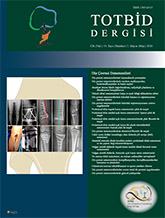
Osteotomies around the knee are still a current treatment option, despite the advances in knee replacement. It is possible to obtain long-term satisfactory results in especially young and active patients with the early stages of knee osteoarthrosis. In addition to compensating for abnormal load distribution, osteotomies can be used to protect repaired tissues in the event of chondral damage or meniscus defects involving a single compartment. It is preferred as a time-buying surgical procedure in osteoarthrosis in middle ages. Proximal tibial medial open wedge osteotomy is the most commonly used method for the quite common varus deformities. However, depending on the location, cause and amount of the deformity, varus / valgus, open / closed wedge osteotomy in the distal femur and combined osteotomies in both femur and tibia can be simultaneously performed. The successful outcome is closely related to the preoperative analysing of the patient and the selection and application of surgical techniques appropriate to the biomechanical principles. Therefore, each case should be evaluated meticulously considering deformity, the condition of ligaments in the knee and other structures such as meniscus and cartilage within the knee joint. Finally, the surgical techniques to reposition the mechanical axis in the most appropriate location, can be chosen.